Myers' Psychology Unit 1: Biological Bases of Behavior
Module 1.1 Interaction of Heredity and Environment
the nature-nurture issue is the longstanding controversy over the relative contributions that genes and experience make to the development of psychological traits and behaviors
Charles Darwin proposed the process of natural selection where inherited traits that allow an organism to survive and reproduce in a specific environment are most likely to be passed on by nature to succeeding generations
evolutionary psychology is the study of the evolution and behavior and the mind, using principles of natural selection (the nature side)
nature selects advantageous variations from the new gene combinations produced at human conception alongside mutations
mutations are random errors in gene replication that leads to a change
humans share similarities through the human genome or the instructions for making an organism
behavior genetics is the study of the relative power and limits of genetic and environmental influences on behavior (the nurture side)
environment is every nongenetic influence, from prenatal nutrition to our experiences of the people and things around us
heredity is the genetic transfer of characteristics from parents to offspring
genes are the biochemical units of heredity
identical (monozygotic) twins develop from a single fertilized egg that splits, creating two genetically identical organisms
sometimes twins don’t have the same number of copies of genes accounting for illness risks, and sometimes separate placentas providing different nourishment
fraternal (dizygotic) twins develop from separate fertilized eggs, and are genetically no closer than ordinary siblings yet share a prenatal environment
twin studies allow psychologists to ethically dive into the heredity and behavioral aspects of study without breaching the line of subjecting humans to conditions; natures experiment for us finds identical twins share nearly all personality and factors in life while fraternal twins are far less likely too
adoption creates two groups: genetic relatives (biological) and environmental relatives (adoptive)
people who grow up together do not much resemble one another in personality, while traits such as extraversion and agreeableness are more similar to their biological parents than to their caregiving adoptive parents
environments shared by a family’s children have little impact on their personalities
adoptive families experience less child neglect, abuse, parental divorce, and see an increase in gentler parenting, guidance, and less depression - the biggest takeaway being adopted children thrive and benefit from adoption leading to higher intelligence, self-giving traits, and more
interaction is the interplay that occurs when the effect of one factor (such as environment) depends on another factor (such as heredity)
humans have enormous adaptive capacity and the biological mechanism allows genes and experiences to shape us
epigenetics study the molecular mechanisms by which environments can influence genetic expression without DNA change
genes are self-regulating and controlled by our environments and experiences, creating epigenetic marks, that instruct the cell to ignore the gene and turn it off
epigenetic changes have led evolutionary biologists to believe inheritance occurs through environmental influence, evolution shaping culture in return influencing future evolution
Module 1.2 Overview of the Nervous System
our nervous system is the body’s electrochemical communication network consisting of all the neurons of the peripheral and central nervous systems
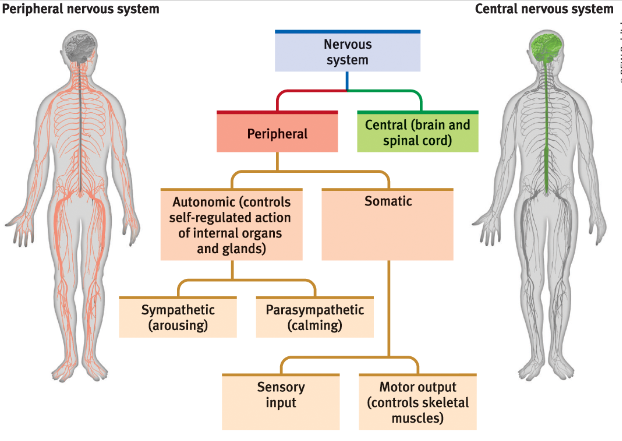
the brain and spinal cord form the central nervous system (the body’s decision maker)
the peripheral nervous system is made up of the sensory and motor neurons that connect the CNS to the rest of the body
nerves are bundled axons that form neural cables connecting the central nervous system with the muscles, glands, and sensory organs
information travels through the nervous system in three types of neurons:
sensory (afferent) neurons carry messages from the body’s tissues and sensory receptors toward the brain and spinal cord
motor (efferent) neurons carry messages from the CNS to the body’s muscles and glands
interneurons exist within the CNS and communicate internally and process information between sensory inputs and motor outputs
our somatic nervous system is one component of the peripheral nervous system that control’s the voluntary control of our skeletal muscles
the automatic nervous system controls the glands and internal organs (self-regulating) and is divided into two subdivisions to keep homeostasis
the sympathetic nervous system arouses and expends energy (“fight or flight” system) - accelerates heartbeat, raises BP, slows digestion, raises blood sugar, etc.
the parasympathetic nervous system calms and conserves energy (“rest and digest”)
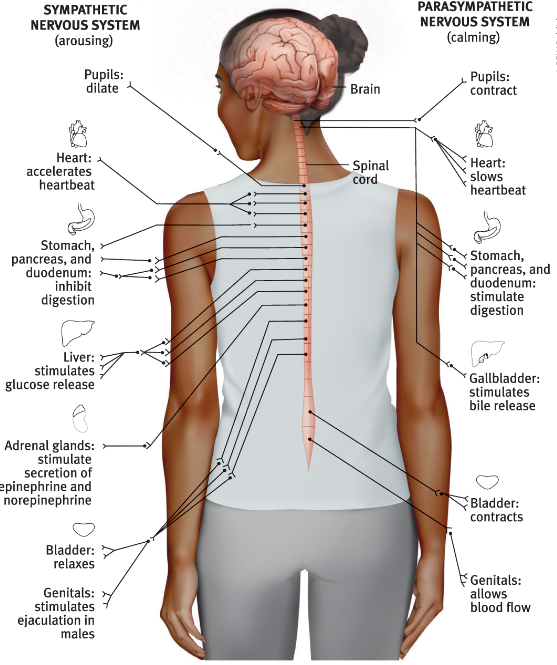
neurons cluster into work groups known as neural networks to enable fast, short, connections
the spinal cord is the two-way highway connecting the peripheral nervous system to the brain
the spinal cord involves neural pathways that govern reflexes or our automatic responses to sensory stimuli such as a knee jerk
the reflex arc is a simple spinal reflex pathway composed of a single sensory neuron and single motor neuron communicating through interneurons
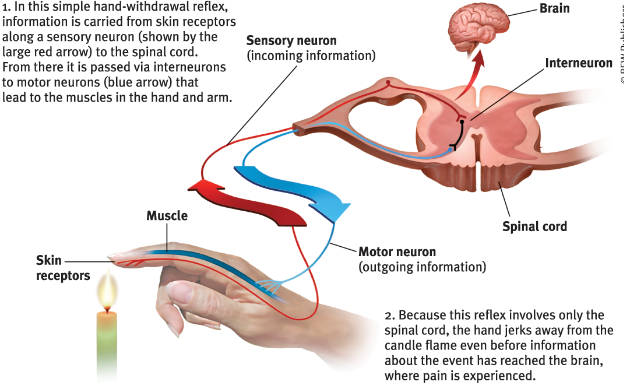
Module 1.3b The Neuron and Neural Firing: Substance Use Disorders and Psychoactive Drugs
neurons or nerve cells are the basic building blocks of the nervous system
neurons consist of the following structures and components, following the path of dendrites > cell body > axon > terminal branches
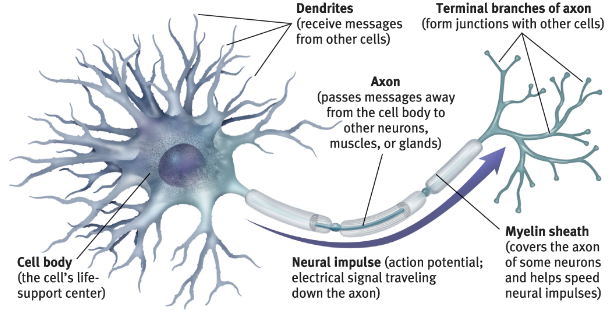
dendrites are typically slow while axons can stretch across the entire body, thanks to the myelin sheath: a fatty tissue layer that encases the axons of some neurons and allows them to speed up neural impulses as they hop from nodes
deterioration leads to diminished control, slower reactions, multiple sclerosis
glial cells support, nourish, and protect neurons by providing nutrients, cleaning, and guiding connections, also play a role in learning, thinking, and memory
neural impulses result in an action potential or a brief electrical charge that travels down an axon
neurons generate electricity through the chemical event of ions being exchanged
the fluid outside the axon has (+) ions, resting interior fluid having (-) ions, and leaves the neuron in a resting potential state
when neurons fire, axons open and allow (+) ions to enter causing in depolarization
when excitatory neural signals exceed inhibitory neural signals (threshold, or the amount of stimulation required to trigger) results in an action potential
neurons need breaks and undergo a refractory period where action potentials cannot occur until the axon recharges and returns to its resting state
an all-or-none response is a neuron’s reaction of either firing or not firing, never in varying intensity
synapses are the junction between the axon tip of the sending neuron and the dendrite of the receiving neuron, the tiny gap at this point being called the synaptic gap/cleft
chemical messengers cross the synaptic gap between neurons are known as neurotransmitters, binding to receptor sites on the receiving neurons and influencing whether the neuron will generate a neural impulse
brain pathways use a few to affect specific behaviors and emotions
the excess neurotransmitters are broken down or go through reuptake, the reabsorbing from the sending neuron

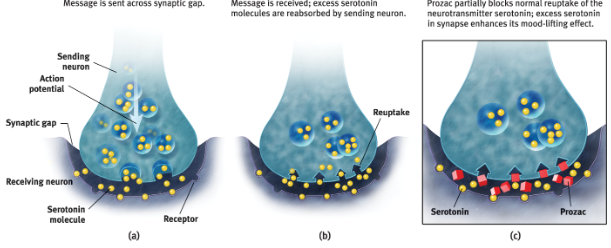
NEUROTRANSMITTER | FUNCTION | MALFUNCTION |
Acetylcholine (ACh) | Enables muscle action, learning, and memory |
|
Dopamine | Influences movement, learning, attention, and emotion |
|
Serotonin | Affects mood, hunger, sleep, and arousal |
|
Norepinephrine | Helps control alertness and arousal |
|
GABA (gamma-aminobutyric acid) | A major inhibitory neurotransmitter |
|
Glutamate | A major excitatory neurotransmitter involved in memory |
|
Endorphins | Neurotransmitters that influence the perception of pain or pleasure |
|
Substance P | Involved in pain perception and immune response |
|
when the brain is flooded with opioid drugs, the brain may stop producing natural opioids to maintain the chemical balance - explaining the effect of withdrawal
agonist molecules increase neurotransmitter’s actions in production and release, blocking reuptake, or mimicking and binding to the receptor
antagonist molecules decrease neurotransmitter’s actions by blocking production or release, occupying and blocking the receptor
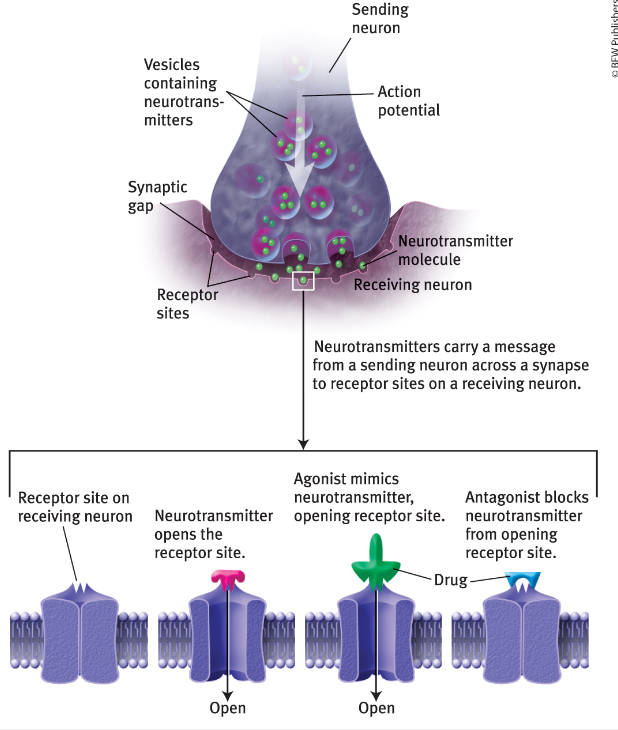
the endocrine system is our body’s “slow” chemical communication system of glands and fat tissue responsible for secreting hormones into the bloodstream
hormones are chemical messengers formed by the endocrine that influence tissues and interests
though chemically identical to neurotransmitters, messages tend to outlast the effects of neural messages
the adrenal glands on top of the kidney release epinephrine and norepinephrine (adrenaline and noradrenaline) to increase heart rate, BP, and the fight-or-flight response
the pituitary gland located in the brain secretes growth hormones, oxytocin (orgasm/social hormone) and directs other glands to release their hormones
Module 1.3b The Neuron and Neural Firing: Substance Use Disorders ad Psychoactive Drugs
psychoactive drugs are chemical substances that alter the brain, producing changes in perceptions and moods
a substance use disorder is characterized by continued substance use despite resulting life disruption and typically is exhibited through any of the following four indicators:
diminished control (uses more or longer than needed, no regulation, craves)
diminished social functioning (commitment issues, social problems, reduced activities)
hazardous use (continues despite worsening symptoms/hazards)
drug action (tolerance, withdrawal)
the tolerance describes the diminishing effect with regular use of the same dose of drug, requiring larger doses to experience the same effect as before
addiction is an everyday term for compulsive substance use or dysfunctional behavior patterns that continue despite consequences
discontinuing can result in the discomfort and distress known as withdrawal
depressants are drugs that reduce neural activity and slow body functions
alcohol is a depressant that acts as a disinhibitory on judgement and inhibitions, resulting in helpful tendencies (tipping, partying) and harmful tendencies (sexual aggression, perception of attraction, sexual desire)
alcohol use disorder from excessive drinking can result in brain shrinkage and premature death, younger women being more susceptible due to lacking an enzyme in the stomach
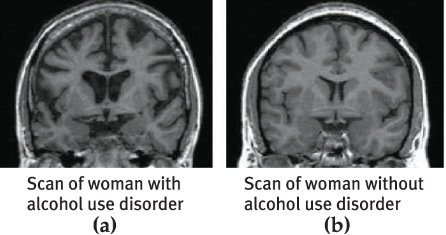
alcohol slows the sympathetic nervous system and results in slow reactions, slurred speech, low performance, and combined with other factors result in lowered inhibitions that could be deadly - also suppresses gag reflex from vomiting toxins in stomach, leading to potential overdoses
disrupts memory formation and cognition by contributing to nerve cell death, reducing the birth of new cells, and impairing the growth of synaptic connections - also suppresses REM sleep which formulates the day
alcohol disrupts self-awareness and causes us to zone out and focus on arousing situations, develops higher chances of substance use, and controls sexual desires otherwise not found
barbiturates depress nervous system activity, reduce anxiety, and impair memory and judgement
opioids (opium and derivatives) depress neural functioning by temporarily lessening pain and anxiety
includes heroin and pain-relief narcotics that replace pain and anxiety with pleasure, leading to addictions and the eventual stopping of natural endorphins being produced by the brain - overdose becoming common
stimulants excite neural activity and speed up body functions, resulting in an alert, weight lost, and boosted mood, typically addictive and results in impaired sleep
tobacco products release nicotine found in cigarettes, cigars, chewing tobacco, snuff, and e-cigarettes which release jolts of nicotine - correlated with happier lives, less depression, disabilities, and divorce if avoided
tobacco products are powerful and quickly addictive, building tolerances alongside withdrawal symptoms, typically resulting in the inability to focus on a task with cravings
nicotine signals the CNS to release neurotransmitters, epinephrine and norepinephrine boosting alertness and efficiency while dopamine and opioids calm anxiety or pain
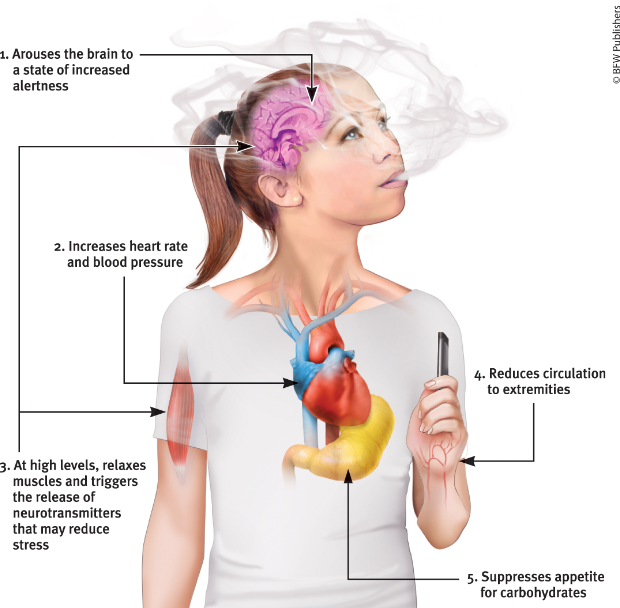
cocaine is an addictive stimulant that is snorted, injected, or smoked as a crystallized form to produce intense highs, entering the bloodstream and producing euphoria depleting the brain’s supply of dopamine, serotonin, and norepinephrine
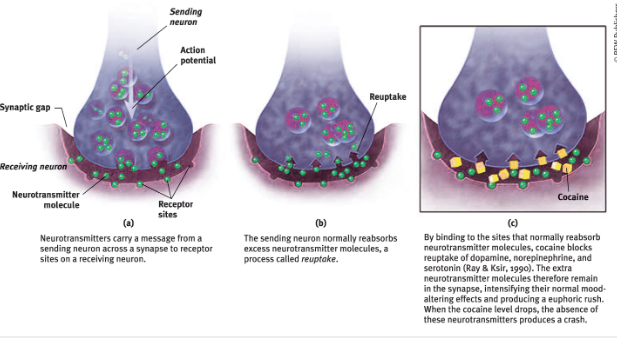
cocaine heightens reactions like aggression and stimulates the brain’s reward pathways, affected by expectations and personality
amphetamines such as methamphetamine stimulate neural activity by increasing energy and mood
trigger the release of dopamine to stimulate and enhance feelings of euphoria - overtime reducing baseline levels leading to depression
ecstasy (methylenedioxymethamphetamine or Molly) is a stimulate and hallucinogen
similar to meth reduces dopamine, but stores serotonin and blocks reuptake prolonging the feel-good flood of high energy, emotional elevation, and "connectedness”
highly dehydrating, damages serotonin-producing neurons, decreased output and higher rates of depression alongside suppressing immune system, memory, and sleep
hallucinogens or psychedelic drugs distort perception and evoke sensory imagines in the absence of sensory input
experiences are characterized by geometric forms, followed by meaningful images, tunnel vision, emotional experiences, separation from body, dreamlike sensation from the visual cortex
often mimic the near-death experience or an altered state of consciousness reported after a close brush with death, resulting in enhanced spirituality and personal growth - possibly created by the brain in stress
LSD (lysergic acid diethylamide) or “acid” range from euphoria and detachment to panic, mood and expectations dictating the experience similar to perceptual distortions and hallucinations
marijuana contains THC which is responsible for producing a mix of effects of hallucinations, delusions, or anxiety and can be mimicked with synthetic versions
amplifies sensitivity to sensory input, but, relaxes and disinhibits to produce the euphoric high, sometimes used to aid sleep or mood, yet impairs motor coordination, perceptual skills, and reaction time
THC is not flushed by the body and lingers in the body’s tissue yet can alleviate chronic pain, nausea, soreness, short-term sleep improvement, no risk of lung cancer, increases accidents, bronchitis, and impairs our brain
higher risks of depression, anxiety, psychosis, and suicidal behavior for young people as a “neurotoxin”
DRUG | TYPE | PLEASURABLE EFFECTS | NEGATIVE EFFECTS |
Alcohol | Depressant | Initial high followed by relaxation and disinhibition | Depression, memory loss, organ damage, impaired reactions |
Heroin | Depressant | Rush of euphoria, relief from pain | Depressed physiology, loss of natural endorphin function |
Caffeine | Stimulant | Increased alertness and wakefulness | Anxiety, restlessness, and insomnia with high doses |
Nicotine | Stimulant | Arousal and relaxation, sense of well-being | Heart disease, cancer |
Cocaine | Stimulant | Rush of euphoria, confidence, energy | Cardiovascular stress, suspiciousness, depressive crash |
Methamphetamine | Stimulant | Euphoria, alertness, energy | Irritability, insomnia, hypertension, seizures |
Ecstasy | Stimulant; mild hallucinogen | Emotional elevation, disinhibition | Dehydration, overheating, depressed mood, impaired cognitive and immune functioning |
LSD | Hallucinogen | Visual “trip” | Risk of panic |
Marijuana | Mild hallucinogen | Enhanced sensation, relief of pain, distortion of time, relaxation | Impaired learning and memory, increased risk of psychological disorders |
Module 1.4a The Brain: Neuroplasticity and Tools of Discovery
phrenology is an outdated study of the bumps on ones skull to reveal a person’s mental abilities and character traits, an early idea of the localization of function or the idea that various brain regions have particular functions
biological psychology is the study of the links between biological (genetic, neural, hormonal) and psychological processes
humans are biopsychosocial systems, and the key to understanding our behavior is through the biopsychosocial approach with integrates an approach that incorporates biological, psychological, and social-cultural levels of analysis
levels of analysis are the differing complementary views, from biological to psychological to social-cultural, for analyzing any given phenomenon in our behaviors or mental processes
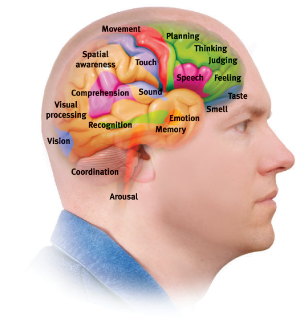
neuroplasticity is the brain’s ability to change, highest during childhood, by reorganizing after damage or building new pathways based on experiences
usually contributes to larger hippocampus, auditory cortex areas, etc. - all a result of your brain being a work a progress producing subtle brain changes to allow us to adapt to our changing world
scientists aiming to study the brain outside of case studies involving past trauma use a lesion, or a tissue destruction, to observe any effects on brain function or by using electrical, chemical, or magnetic stimulation
scientists today are able to detect electrical pulses in single neurons and chart information’s travel, alongside emerging optogenetics or the control of an individual neuron’s activity, and through various techniques
an EEG (electroencephalogram) is an amplified recording of the waves of electrical activity sweeping across the brain’s surface by placing an electrode on the scalp
an MEG (magnetoencephalography) uses a head coil to measure magnetic fields from the brain’s natural electrical activity and construct an image of the strength and speed on influencing activity
CT (computed tomography) scan is a series of X-ray photographs taken from different angles and combined by a computer into a composite slice of the brain’s structure helpful for brain damage
PET (positron emission tomography) detects brain activity by displaying where a radioactive form of glucose goes when the brain performs a given task, showing “hot spots” of consumption
in MRI (magnetic resonance imaging) scans, magnetic fields and radio waves produce computer-generates images of soft tissues and brain anatomy
an fMRI (functional MRI) reveals blood flow and brain activity when compared to successive MRI scans, revealing brain function
Module 1.4b: The Brain: Brain Regions and Structures
the hindbrain consists of the medulla, pons, and cerebellum; directs essential survival functions, such as breathing, sleeping, and wakefulness, as well as coordination and balance
the midbrain on tops of the brainstem connects the hindbrain with the forebrain, controlling some motor movement while primarily transmitting auditory and visual information
the forebrain consists of the cerebral cortex, thalamus, and hypothalamus; managing complex cognitive activities, sensory and associative functions, and voluntary motor activities
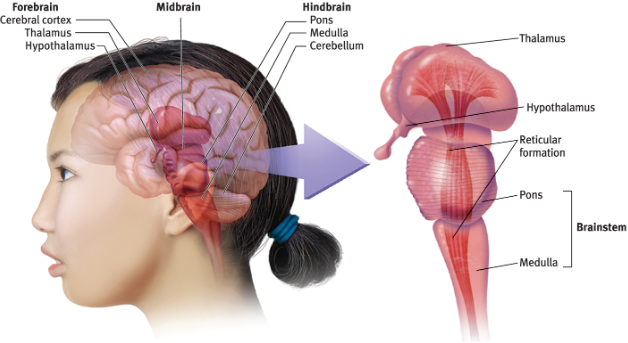
the brainstem is the innermost region, and the central core of the brain beginning where the spinal cord enters the skull, responsible for automatic survival functions
also serves as a crossover point where nerves from each side of the brain connect with the body’s opposite side
the medulla is the hindbrain structure that is the brainstem’s base, responsible for controlling heartbeat and breathing
the pons coordinates movements and controls sleep
on top of the brainstem is the forebrain’s thalamus, egg-structures that act as the sensory control center directing messages to the sensory receiving areas in the cortex and transmitting replies to the cerebellum and medulla
inside the brainstem lies the reticular formation, a nerve network that travels through the brainstem into the thalamus filtering information stimuli and controlling arousal
the cerebellum is the hindbrain’s “little brain” at the rear of the brainstem; its functions include processing sensory input, coordinating movement output and balance, and enabling nonverbal learning and memory
the cerebellum is responsible for procedural learning, coordination, and subconscious learning thanks to half of our neurons living here
the limbic system is the neural system located in the forebrain, below the cerebral hemispheres, that includes the amygdala, hypothalamus, hippocampus, thalamus, and pituitary gland, associated with emotions, drives, and memory formation
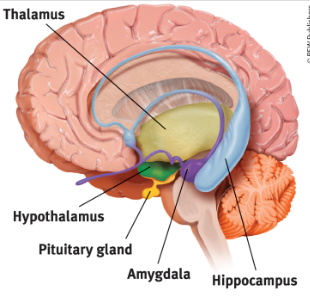
the amygdala, two lima-bean sized neural clusters, enable aggression and fear emotions
the hypothalamus lying below the thalamus directs maintenance activities (eating, drinking, body temperature, sexual behavior), helps govern the endocrine system to maintain homeostasis linking emotion as a reward
the hypothalamus is one example of a reward center or a center that self-stimulates itself releasing dopamine-pleasure
it monitors blood chemistry and incoming orders from the brain to control the endocrine system
the hippocampus is a neural center in the limbic system that helps process explicit (conscious) memories of facts and events for storage
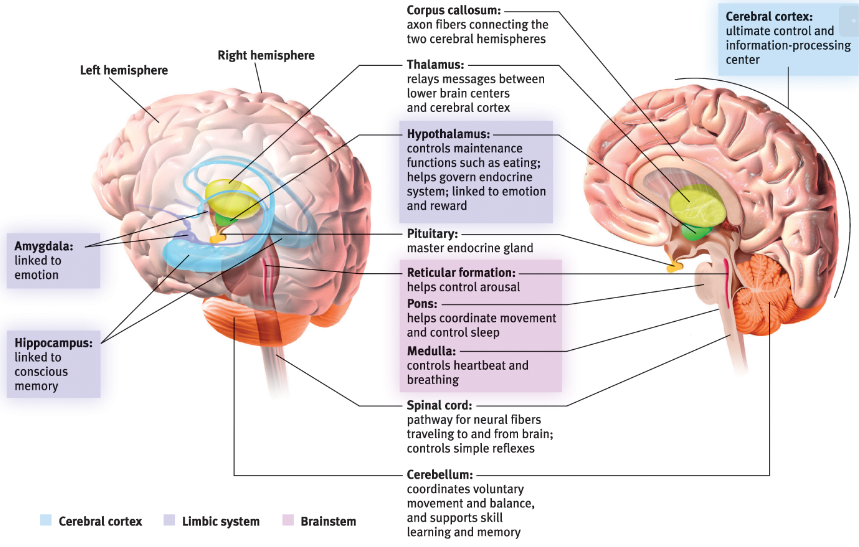
the cerebrum are the two cerebral hemispheres that constitute 85% of the brain and enable our perceiving, thinking, and speaking
the cerebral cortex is a fabric of interconnected neural cells that cover the forebrain’s cerebral hemispheres, the ultimate control and information-processing center - composed of axons connecting it to other regions
each hemisphere’s cortex is divided into four lobes separated by fissures
the frontal lobes are the part of the cortex lying behind the forehead, enabling linguistic processing, muscle movements, higher-order thinking, and executive functioning (making plans, judgement)
the parietal lobes are the part of the cortex lying on top of the head in the read, responsible for receiving sensory input for touch and body position
the occipital lobes are the part of the cortex in back of the head, including areas that receive information from the visual fields
the temporal lobes are the part of the cortex above the ears responsible for auditory areas enabling language processing from the opposite ear
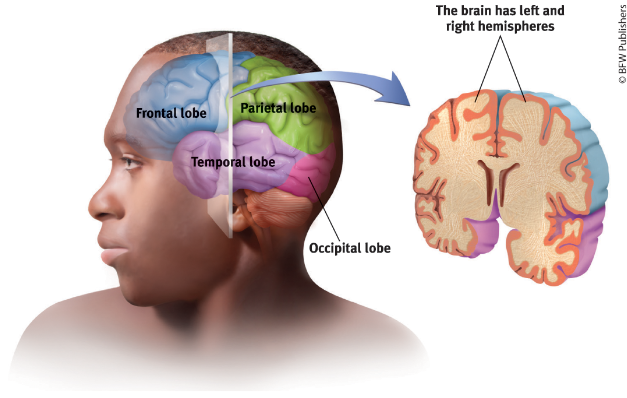
the motor cortex is the cerebral cortex area at the back of the frontal lobes responsible for controlling voluntary movements
body areas requiring precise control, such as the fingers and mouth, occupy the greatest amount of cortical space and power
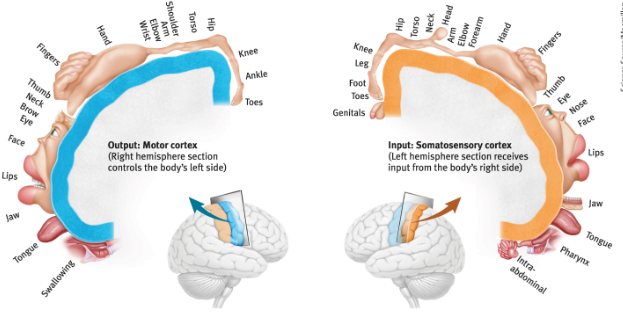
cognitive neural prosthetics allow scientists to model and collect activity of signals to move the motor cortex’s appropriate body part
the somatosensory cortex is a cerebral cortex area behind the motor cortex, front of the parietal lobes, that registers and processes body touch and movement sensations
body regions with more sensitivity have larger cortical space and power, alongside the
the visual cortex sits in your occipital lobes, receiving visual information, and sending it other areas that specialize in tasks like identifying words, emotions, faces
the auditory cortex sits in your temporal lobes above your ears, traveling from one ear to the area above the opposite ears
areas of the cerebral cortex not involved in primary motor or sensory functions are referred to as association areas, and are involved in higher mental functions like learning, remembering, thinking, and speaking
the prefrontal cortex in the front part of the frontal loves enables judgement, planning, social interactions, and memory processing - damage results in impulsivity, moral judgements turn negative
Phineas Gage had a rod fired through his head and resulted in frontal lobe damage, altering his emotion and decision making changing his personality
the parietal lobes enable mathematical and spatial reasoning - meaning the perception of moving comes from the intention not the movement itself
the right temporal lobe enables us to recognize faces
the brain itself relies on functional connectivity or communication among distinct brain areas and neural networks for all tasks
Module 1.4c The Brain: Damage Response and Brain Hemispheres
brain-damage effects, like severed brain and spinal cord neurons, usually do not regenerate; however, some neural tissue can reorganize itself in response to damage
neuroplasticity occurs after serious damage, especially in young children, and develops extra connections in the undamaged hemisphere or uses old space for expansion (visual cortex for sense of touch in blind individuals, temporal lobes for sign language)
neurogenesis is the formation of new neurons
stem cells may one day be an option for surgeons to rebuild damaged brains outside of natural neurogenesis
lateralization is the brain’s division of functions between the left and right hemispheres
left-hemisphere accidents impair reading, writing, speaking, arithmetic reasoning, and understanding
right-hemisphere actions yield less dramatic effects
the corpus callosum is the large band of neural fibers connecting the two brain hemispheres that carrying messages between them
severing the band results in a split brain or a surgery that separates the brain’s two hemispheres by cutting the fibers connecting them
the information sharing in a split corpus callosum does not occur in vision, speech, and decision and leaves individuals with “two separate minds” simultaneously different comprehensions, unaware of the influence on the other
the left-hemisphere often times is confused and rationalize reactions it does not understand - if told to “walk” on the right hemisphere, the left might improvise and interpret the explanation on why it is occurring
when people perform perceptual tasks, the right hemisphere ignites while the left increases during speaking or mathematical calculations
deaf and hearing people use the left hemisphere to process language, and often makes skilled literal interpretations of the language
the right hemisphere is also able to make inferences and quickly reason conclusions and solutions, modulates speech for clarity, and aids in orchestrating self awareness